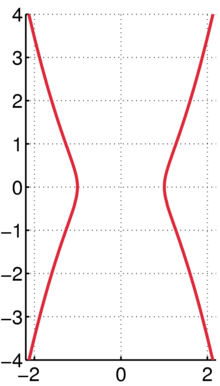Kampyle of Eudoxus

The Kampyle of Eudoxus (Greek: καμπύλη [γραμμή], meaning simply "curved [line], curve") is a curve with a Cartesian equation of
from which the solution x = y = 0 is excluded.
Alternative parameterizations
In polar coordinates, the Kampyle has the equation
Equivalently, it has a parametric representation as
History
This quartic curve was studied by the Greek astronomer and mathematician Eudoxus of Cnidus (c. 408 BC – c.347 BC) in relation to the classical problem of doubling the cube.
Properties
The Kampyle is symmetric about both the x- and y-axes. It crosses the x-axis at (±a,0). It has inflection points at
(four inflections, one in each quadrant). The top half of the curve is asymptotic to as , and in fact can be written as
where
is the th Catalan number.
See also
- List of curves
References
- J. Dennis Lawrence (1972). A catalog of special plane curves. Dover Publications. pp. 141–142. ISBN 0-486-60288-5.
External links
- O'Connor, John J.; Robertson, Edmund F., "Kampyle of Eudoxus", MacTutor History of Mathematics Archive, University of St Andrews
- Weisstein, Eric W. "Kampyle of Eudoxus". MathWorld.





















